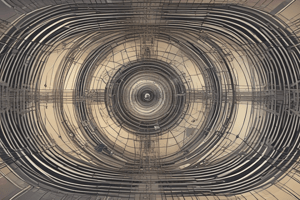Podcast
Questions and Answers
What is the center of mass of a three-dimensional object?
What is the center of mass of a three-dimensional object?
The point where its mass is equally distributed in all directions.
Does the center of mass always coincide with the geometric center of an object?
Does the center of mass always coincide with the geometric center of an object?
No, its location is dependent on the object's mass distribution.
Where is the center of mass of a system of particles located?
Where is the center of mass of a system of particles located?
Within the system's boundaries, at a position where the sum of the vector distances from each particle to the COM is zero.
What happens to an object's center of mass if the object rotates or changes shape?
What happens to an object's center of mass if the object rotates or changes shape?
When is linear momentum conserved in relation to the center of mass?
When is linear momentum conserved in relation to the center of mass?
How is the center of mass of a three-dimensional object calculated?
How is the center of mass of a three-dimensional object calculated?
Where does the center of mass lie in a cuboid?
Where does the center of mass lie in a cuboid?
Where does the center of mass lie in a cylinder?
Where does the center of mass lie in a cylinder?
Where does the center of mass lie in a sphere?
Where does the center of mass lie in a sphere?
What role does the center of mass play in cinematography?
What role does the center of mass play in cinematography?
How is the center of mass utilized in robotics?
How is the center of mass utilized in robotics?
How is the center of mass used in architecture?
How is the center of mass used in architecture?
Flashcards are hidden until you start studying
Study Notes
Understanding the Center of Mass in Three Dimensions
The center of mass (COM), often referred to as the center of gravity when dealing with objects in a gravitational field, is a vital concept in the study of physics and engineering. In three dimensions, the center of mass serves as a fundamental point that helps us describe the motion and behavior of objects.
Definition and Properties
The center of mass of a three-dimensional object is the point where its mass is equally distributed in all directions. This point can be visualized as the location where you would place a single particle to simulate the behavior of the entire object. The center of mass does not always coincide with the geometric center of an object, and its location is dependent on the object's mass distribution.
Some key properties of the center of mass in three dimensions include:
- The center of mass of a system of particles is always within the system's boundaries and in a position where the sum of the vector distances from each particle to the COM is zero.
- An object's center of mass remains fixed relative to the object itself, even if the object rotates or changes shape.
- Linear momentum is conserved if the center of mass remains stationary.
Calculating the Center of Mass
Calculating the center of mass of a three-dimensional object involves finding the sum of the product of each particle's mass and its position vector, then dividing the result by the total mass of the object. For a system of N particles, this can be expressed as:
[ \bar{r_{\text{COM}}} = \frac{1}{m_{\text{total}}} \sum_{i=1}^{N} m_i \mathbf{r}_i ]
where (m_i) is the mass of the (i)-th particle, (\mathbf{r}i) is its position vector, and (m{\text{total}}) is the total mass of the system.
Center of Mass of Common Shapes
Let's take a look at a few common, three-dimensional shapes and their centers of mass:
- Cuboid: The center of mass of a cuboid lies at its geometric center, i.e., at the intersection of its three orthogonal midplanes.
- Cylinder: The center of mass of a cylinder lies at the intersection of its axis and the plane that divides the cylinder's mass into two equal parts.
- Sphere: The center of mass of a sphere lies at its geometric center, i.e., the point where all radial distances are equal.
Applications of the Center of Mass
The center of mass plays a critical role in numerous areas, including:
- Cinematography: In filmmaking, the center of mass of a moving object helps determine the motion required to simulate its behavior.
- Robotics: Robotic systems are often designed to position their center of mass in specific locations to improve stability and control.
- Architecture: Structural engineers use the center of mass to design buildings with optimal stability and to withstand various forces.
Understanding the center of mass in three dimensions is a fundamental concept in the fields of physics, engineering, and mathematics. By studying the behavior of the center of mass, we can better understand and analyze physical systems in a wide range of applications.
Studying That Suits You
Use AI to generate personalized quizzes and flashcards to suit your learning preferences.




